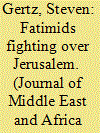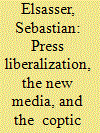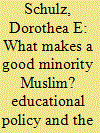| Srl | Item |
| 1 |
ID:
172444


|
|
|
|
|
| Summary/Abstract |
This study presents an Islamic vision of Jerusalem marked not so much by interreligious conflict but by intrareligious or sectarian concern. It does so by reexamining the decision of the Ismāʿīlī Fāṭimid caliph al-Ḥākim to destroy the Church of the Holy Sepulchre in the year 1009 as recorded in al-Maqrīzī’s Lessons for True Believers in the History of the Fatimid Imams and Caliphs. In the process, it considers the influence that a mosque built in honor of the second caliph ʿUmar b. al-Khaṭṭāb, conqueror of Jerusalem, may have had during the Fāṭimid era. The article also considers another significant event in Jerusalem recorded by the Crusader-era bishop William of Tyre, in which the Fāṭimid caliph al-Mustanṣir, fearing a Sunnī Saljūq advance on the city, forced the Christians of Jerusalem to build part of the city wall in the early 1060s. The work also looks briefly at the The Pillars of Islam, the main legal work of the formative Fāṭimid jurist al-Qāḍī al-Nuʿmān, to help demonstrate the connection between intrareligious and interreligious tension present in Fāṭimid thought. More generally, this article engages with and adds to a growing body of literature on religious identity formation, which seeks to understand the process of how a community goes about forming its religious identity in the context of surrounding influences as well as through its internal development.
|
|
|
|
|
|
|
|
|
|
|
|
|
|
|
|
| 2 |
ID:
093764


|
|
|
|
|
| Publication |
2010.
|
| Summary/Abstract |
The introduction of new media (internet, satellite TV) in the 1990s and the liberalization of the Egyptian press in the 2000s have brought the Coptic minority and its demands for equality and recognition to the forefront of public debate in Egypt. The consequences are diverse: more and sometimes better information and more room for the discussion of uncomfortable truths on the one hand, irresponsible sensationalism, the propagation of new and old prejudice, and a further strengthening of exclusive religious identities on the other hand. Government policies, though, rightly criticized as contributing to the current crisis in Muslim-Christian relations, have so far remained unaffected.
|
|
|
|
|
|
|
|
|
|
|
|
|
|
|
|
| 3 |
ID:
119173


|
|
|